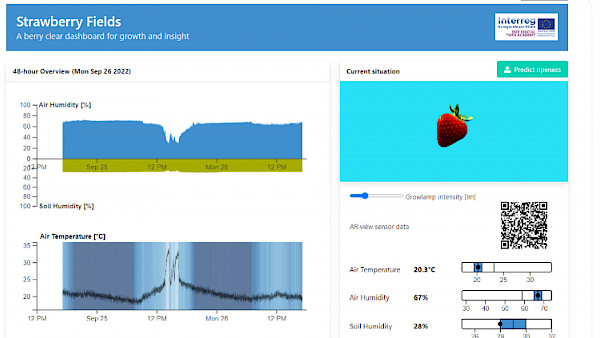Learn to build digital twins with strawberries
Digital twinning has been identified by the NWO (Netherlands Organisation for Scientific Research) as one of the key technologies for the ICT top sector. It is a technology, where a direct virtual twin of reality is applied for a specific purpose, e.g. machine maintenance, design/development or monitoring. The technology promises a lot, but there is a gap between idea and market application. How do you unlock such a technology in a way that it becomes useful, and not only for tech giants? And how do we ensure that there are ICT people who master the principle and start applying it? That is what Tom Langhorst, lecturer-researcher at Fontys ICT, is working on in the Interreg Digital Twin Academy research project.
Digital Twin Academy
The Digital Twin Academy was initiated within from Interreg Meuse-Rhine. Interreg projects aim to stimulate cooperation, and in this case it involves highlighting digital twinning in Dutch and Belgian Limburg, and German Nordrhein-Westfalen. The technology offers opportunities for this region. Langhorst: "The project has four work packages, which together should make digital twinning accessible. The first work package is designed to build a community, the second revolves around providing an introduction to digital twinning as a relatively new phenomenon for professionals. 'Strawberry Fields' falls into the third package, in which we want to develop training opportunities at an MBO+ level. Basically to impart a technical foundation in the principles of digital twining. Specifically for this region, where there is a lot of potential for the manufacturing industry, digital twining could generate new jobs." In addition to these first three work packages, a fourth work package examines a number of applications of digital twinning within specific cases.
 20 euros and a strawberry plant
20 euros and a strawberry plant
So how do you develop a learning module, and more importantly, what do you want to convey? One of the partner bodies had specific equipment on hand for digital twinning; with a price tag of a few tonnes. Langhorst: "Of course, that is not realistic for someone looking for work or considering a move into ICT. So I started thinking whether we could create a set-up for digital twinning for less than €20. That's a reasonable investment." So that worked out, and in the learning module of the Digital Twin Academy, a student needs no more than a laptop, an affordable sensor and a strawberry plant. Preferably also a fixed place to put it, such as on the kitchen table. Not perfect as a digital twin, but extremely suitable for the learning process, Langhorst explains: "The most important thing is to really teach someone the basics of a digital twin. Collecting data, processing it and then visualising it... You can do that with this set-up and then you actually already have a very first step towards a 'cyber physical system'. Such a low-cost sensor is not perfect, of course, but it is precisely embracing imperfection that leads to learning". The fact that the twin is not perfect actually allows a student to see what a twin can and cannot do. But also, collecting data collectively (i.e. the data from lots of strawberry plants) expands the possibilities. Hence the name 'Strawberry Fields', because it creates digital fields full of plants, with data that makes for better models.
Fit for purpose
When we think of digital twinning, we quickly think of exact and synchronous replication of reality. However, that is hugely challenging and costly, especially when we think of natural shapes like plants or complex environments such as cities. Moreover, it is only feasible within a controlled environment, Langhorst explains: "Our case studies show that exact digital twins (a highly accurate synchronous digital replica) are only feasible for a controlled environment, but if we are talking about nature or very complex environments like a city, it is unfeasible." The bottom line is that a digital twin makes sense with a targeted application. For that, the right alignment between issue, reality and data is crucial, especially when it comes to non-controlled environments: "You have to ask yourself the question; what do I need? What do I want to know with a digital twin? If it's about air quality in the city, you might not need a comprehensive virtual replica of all the buildings and shapes in that city. If it's about something like a strawberry plant, you quickly see how limited 3D visualisation is when it comes to natural growth and ripening. The sensor used can measure humidity, temperature, light intensity and soil moisture levels and convert them into data, but says nothing about perhaps hundreds of other factors in your home. Think about light, drafts in the house, your cat's behaviour and much more. Understanding what does and does not make sense with digital twins is perhaps the most important thing to instil in someone who wants to get started with them. The smart use of digital twinning offers many opportunities for the future and, for now, seems mainly driven by what we call fit-for-purpose. So going exactly as far into twinning as makes sense for the bussiness case."
The learning module ‘Strawberry Fields’ is accessible for everyone who is looking for a start with digital twinning. The modules can be found on Youtube and on the learning platform of the Digital Twin Academy project.
'Strawberry Fields' is part of the larger Digital Twin Academy Project by Interreg Euregio Meuse-Rhine (EMR). Within this larger project, digital twins are being unlocked for SMEs and applications of the technology explored in a number of projects. More information via the project website.



